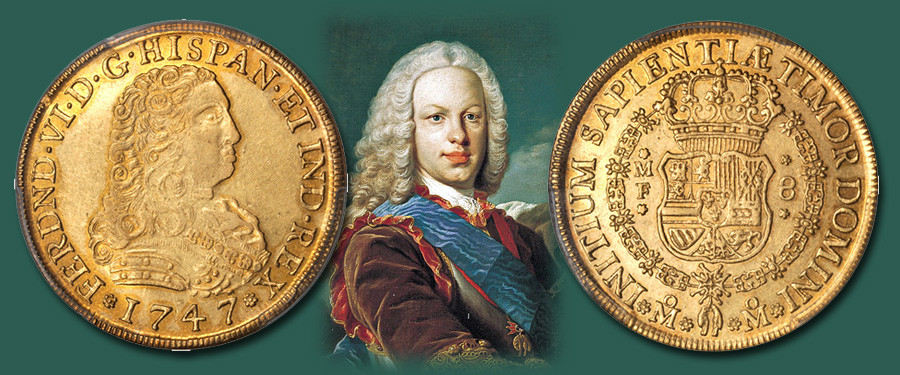
The Stack’s Bowers Galleries August ANA
World’s Fair of Money Showcase Auction, held this year in Anaheim, California,
promises to be a tremendous event. The World coin auction sessions feature some
fantastic rarities and highly collectible types; seemingly there is something
for everyone. High on the list of extraordinary coins is a rare 1747 Mexican 8
Escudos. At this time in history Mexico was a Spanish colony known as the
“Viceroyalty of New Spain.” The Spanish monarch Philip V died in July 1746, and
his son Ferdinand VI succeeded him. One issue facing royal successions at that
time was the travel required to spread the news of the new king’s ascension. It
took many weeks to travel by ship from Spain to the New World, and before the
news of Philip V’s demise reached Mexico, the Mexico City mint had already
begun issuing posthumous issues of Philip V in the early months of 1747. It
took time for the official mint in Spain to create punches with updated
portraits, legends, and icons. In the meantime, the Mexico City mint improvised
a design for Ferdinand VI.
Using a verbal description of the new
King Ferdinand VI of Spain, Mexican mint officials created an “imaginary
portrait” for the obverse of this coin. Ferdinand VI’s royal titles appear
around the bust: “FERDND. VI. D. G. HISPAN. ET IND. REX.” The date appears
below the bust, flanked by two rosettes. A careful examination of the armor
shown on this bust reveals it to be nearly identical to the armor of Philip V,
the predecessor. In all likelihood it was simply copied in order to facilitate
speedy production of the new coinage. The bust itself, as mentioned above, is
known as an “imaginary portraiture” and would not resemble the future official
portrait punches of Ferdinand VI issued by the Madrid mint. This “imagined
portraiture” was unique to the Mexico City mint, was only used for a brief span
of a few months, and was never used at any of the other colonial mints outside
of Mexico. These factors combine to create an extremely rare coin that was only
produced during a short window of time.
The reverse contains an intricate
shield depicting the complex and stunning coat of arms of the King of Spain.
The Crown appears above, and along either side of the shield appears the Order
of the Golden Fleece, a famous Order that has existed for almost 600 years.
Between the chain of the Order and the heraldic shield are displayed the
assayer’s initials on the left and an “8” for 8 Escudos on the right. The
inscription reads: “INITIUM SAPIENTIAE TIMOR DOMINI,” which translates to
“Beginning of Wisdom is Fear of the Lord.” This inscription was the official
motto of Philip V. The reverse design is the same punch reused from the
previous Philip V issue. At the very bottom, between the beginning and end of
the legend and the Golden Fleece, are two “MO” monograms signifying the Mexico
City mint. This rare type was only issued for a few months in the year 1747,
and as such it is extremely rare.
The original and highly attractive
example Stack’s Bowers will be auctioning in August, features warm attractive
golden toning and glossy mirrored surfaces within the protected areas of the
legends. This is a key one-year type and the coin is in exceptionally
high-grade, finer than the Iovino coin and equal to the Norweb and Karon
examples that were among the world’s finest known.
Though our Stack’s Bowers August ANA World’s Fair of Money Auction is no
longer open for consignments, we are now accepting consignments of world and
ancient coins for our January 2017 New York International Auction as well as
Chinese and other Asian coins and currency for our April 2017 Hong Kong
Showcase Auction. If you are interested in consigning your coins and paper
currency (whether a whole collection or a single rarity) be sure to contact one
of our consignment directors





